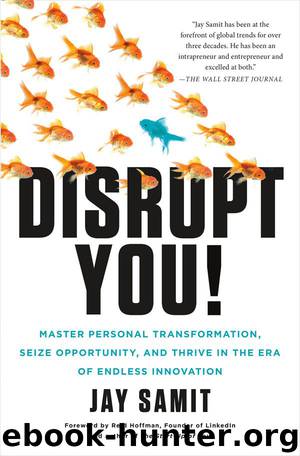Disrupt You!: Master Personal Transformation, Seize Opportunity, and Thrive in the Era of Endless Innovation by Jay Samit

Author:Jay Samit [Samit, Jay]
Language: eng
Format: epub, mobi, azw
ISBN: 9781250059390
Publisher: Flatiron Books
Published: 2015-07-06T22:00:00+00:00
Chapter Ten
Design: Disruption Through Aesthetics
Design is where science and art break even.
—Robin Mathew
Think you can improve upon something already in existence? You are ready to disrupt the design link in the value chain. Michael Kors, Kate Spade, and Tory Burch didn’t invent the handbag. Nike and Converse didn’t invent the running shoe. Unlike innovators who try to disrupt through research and development and must find a new, previously unseen way to introduce something to the marketplace, design disruption focuses on the art of simply building something better. Most first-time entrepreneurs wrongly believe that they have to invent the next big thing in order to be successful. So many entrepreneurs have literally tried to “build a better mousetrap” that the U.S. Patent and Trademark Office has issued over 4,400 patents for mousetraps.1 When our world was dominated by manufacturing businesses, innovation meant either inventing a new widget or engineering a more cost-effective way to manufacture an existing one. Yet in our interconnected mass-market world, even the smallest incremental improvement in design and manufacturing efficiency can yield billion-dollar results. When Nestlé Waters North America, maker of Arrowhead, Poland Springs, and Deer Park bottled water, reengineered its bottles to use 50 percent less resin, it not only saved millions of dollars on the twenty billion bottles it manufactures each year but also reduced its carbon footprint by 55 percent.2 Oftentimes, the real disruption comes not from changes to the product itself but from innovations in packaging design. As with all disruption, design disruption comes from identifying problems where others failed to see a solution.
In our mass-market world, even the smallest incremental improvement in manufacturing efficiency can yield billion-dollar results.
When I was a teenager, all motor oil came in big one-quart cylinders. These clumsy cans had tin tops and bottoms connected by cheap cardboard sides. For nearly half a century they were the only way to buy motor oil for your car. To open them, you savagely jammed an eight-inch spiked metal spout into the flimsy can and poured most of the contents into your engine. Inevitably, your hand slipped on the oily can and you painfully stabbed yourself while the oil dripped onto your engine block, your hands, and your shoes. If your car was down more than a quart, you had to yank out the sharp, slippery spike and hold a second quart steady in your oil-soaked hands to be stabbed again. Every car owner and every gas station used this same ridiculous method of getting oil from a container into a motor. With all motor oils being virtually identical in composition, Quaker State—the U.S. market leader—had a manufacturing advantage. Its factory had the largest, most advanced canning system in the world. Having invested millions in production, it could knock out more cans per hour than the next three competitors combined. While this reduced the cost per unit of its motor oil substantially, its huge investment in canning equipment locked the company into a set form of packaging. Quaker State had spent millions of dollars to buy its competitive advantage through superior means of production.
Download
Disrupt You!: Master Personal Transformation, Seize Opportunity, and Thrive in the Era of Endless Innovation by Jay Samit.mobi
Disrupt You!: Master Personal Transformation, Seize Opportunity, and Thrive in the Era of Endless Innovation by Jay Samit.azw
This site does not store any files on its server. We only index and link to content provided by other sites. Please contact the content providers to delete copyright contents if any and email us, we'll remove relevant links or contents immediately.
Hit Refresh by Satya Nadella(9038)
The Compound Effect by Darren Hardy(8808)
Change Your Questions, Change Your Life by Marilee Adams(7635)
Nudge - Improving Decisions about Health, Wealth, and Happiness by Thaler Sunstein(7615)
The Black Swan by Nassim Nicholas Taleb(7010)
Deep Work by Cal Newport(6879)
Daring Greatly by Brene Brown(6444)
Rich Dad Poor Dad by Robert T. Kiyosaki(6401)
Principles: Life and Work by Ray Dalio(6209)
Man-made Catastrophes and Risk Information Concealment by Dmitry Chernov & Didier Sornette(5921)
Playing to Win_ How Strategy Really Works by A.G. Lafley & Roger L. Martin(5917)
Digital Minimalism by Cal Newport;(5663)
Big Magic: Creative Living Beyond Fear by Elizabeth Gilbert(5610)
The Myth of the Strong Leader by Archie Brown(5425)
The Slight Edge by Jeff Olson(5346)
Discipline Equals Freedom by Jocko Willink(5285)
The Motivation Myth by Jeff Haden(5156)
Stone's Rules by Roger Stone(5026)
The Laws of Human Nature by Robert Greene(4997)
